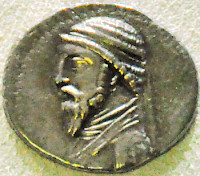Arsaces IX, Artabanus I
Arsaces IX, Artabanus I: Arsacid king of the Parthian Empire (r.126-122). In older literature, this king was also called Artabanus II.

Mithradates I the Great had established the Parthian Empire in what is now called Iran and Iraq. He had died in the final weeks of 132 BCE and had been succeeded by his son Phraates II, who had successfully defended his father's conquests against their former overlord, the Seleucid Empire, but had been killed in action in a war against nomads from the Central Eurasian plains.
The next king was the almost unknow Bagasis, who ruled for about eight months in 127/126 BCE, and was in turn succeeded by a brother of Mithradates, Artabanus.note Like all other kings, he accepted the throne name of "Arsaces"; unlike some of his predecessors, he did not call himself "king of kings" but "great king"; he also used the title of "Philhellene". This means that he presented himself in the same way as Mithradates.
Artabanus bought time in the war against the nomads - the Sacae and Yuezhi are mentioned - by paying tribute. This was more than humiliating: the Arsacid dynasty had its roots in the country of the nomads, so the recognition of the nomads as equals threatened Arsacid legitimacy. It is possible that it was now that a rebel named Hyspaosines started an insurrection in the city of Charax in the south of Babylonia. Artabanus was unable to respond; being occupied in the northeast, he could not prevent Hyspaosines from capturing Babylon. In 122, after a reign of less than five years, the great king was killed during a battle against the Yuezhi.
After the brief reign of Arsaces X, Artabanus was succeeded by his son Mithradates II.
Note
The chronology of the Arsacid kings of the Parthian Empire is less well-understood than, for example, the sequence of Seleucid and Ptolemaic kings or the emperors of Rome. This information is based on the researches by G.R.F. Assar, as published in "Iran under the Arsakids, 247 BC – AD 224/227" in: Numismatic Art of Persia (2011).